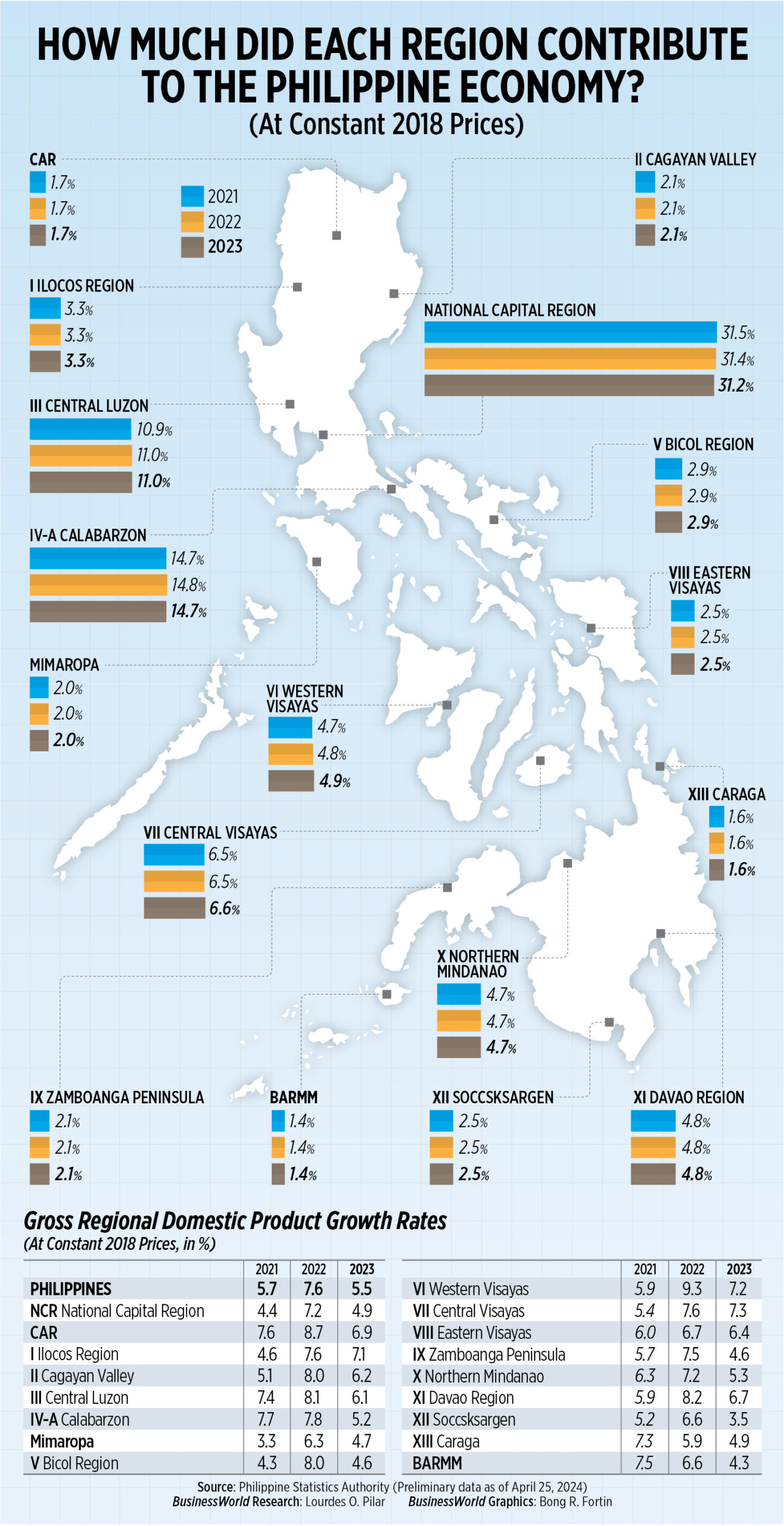NCR economic output grew by 4.9% in 2023

METRO MANILA’S economic output expanded by 4.9% in 2023, the slowest pace in two years, due to base effects and weaker output of key sectors, the Philippine Statistics Authority (PSA) said on Thursday.
Preliminary PSA data on the latest regional accounts showed that the National Capital Region’s (NCR) economic growth slowed sharply in 2023 from the 7.2% expansion in 2022.
This was Metro Manila’s weakest economic growth since the 4.4% print in 2021.
NCR growth was also slower than the Philippines’ 5.5% gross domestic product (GDP) print last year.
“NCR’s growth, although slower, was still in positive territory. An easing from the 2022 figure which reflected the economy’s reopening was only expected,” PSA-NCR Regional Director Paciano B. Dizon said during the briefing.
He also said that base effects are at work with the normalization of the post-pandemic boom becoming apparent in the 2023 GDP growth.
At constant 2018 prices, the economy of NCR amounted to P6.57 trillion last year, 5% higher than P6.27 trillion in 2022.
NCR contributed the largest share to the overall Philippine economy last year at 31.2%, followed by Calabarzon (14.7% share) and Central Luzon (11%).
All 17 regions posted growth in 2023, although slower than the prior year. Eight regions posted economic growth faster than the national average.
Central Visayas was the fastest-growing region at 7.3%, easing from 7.6% in 2022. This was followed by Western Visayas at 7.2% (from 9.3%) and Ilocos Region at 7.1% (from 7.6%).
Meanwhile, Soccsksargen recorded the slowest growth among the regions with 3.5% in 2023, from 6.6% in 2022. It was followed by the Bangsamoro Autonomous Region in Muslim Mindanao (4.3% from 6.6%), Bicol Region (4.6% from 8%), and Zamboanga Peninsula (4.6% from 7.5%).
Metro Manila’s economy was primarily driven by services, which accounted for 82.7% of its economy. Services increased by 5.7% last year, slowing from 8.2% in 2022.
Wholesale and retail trade, which accounted for more than a fourth of services, grew by 4.4% in 2023, slower than 7.2% in 2022.
Financial and insurance activities, which made up 24% of services, expanded by 8% last year versus 7.1% in 2022. Professional and business services growth slowed to 5.8% last year from 9.6% in 2022.
Meanwhile, industry, which accounted for 17.3% of the NCR economy, grew by 1.3% last year, slower than the 3.2% in 2022.
Agriculture, which accounted for 0.01% of NCR’s economy, was the only major sector that posted annual growth. Agriculture expanded by 5.4% in 2023 versus 3.5% in 2022.
“Contributing to [NCR’s] slowdown despite the country’s full reopening include inflationary pressures amidst high policy rate,” Security Bank Corp. Chief Economist Robert Dan J. Roces said in a Viber message.
The Monetary Board has hiked borrowing costs by 450 bps from May 2022 to October 2023, bringing the policy rate to a near 17-year high of 6.5% Headline inflation averaged 6% last year.
“The (NCR) growth is slower than what it should be due to the higher interest rates, volatility in the market, and supply chain constraints,” John Paolo R. Rivera, president and chief economist at Oikonomia Advisory & Research, Inc., said in a Viber message.
By sectoral output, Western Visayas had the quickest growth in services to 10.2% last year but slower than the 13% in 2022. It was followed by Cordillera Administrative Region (8.9% from 10.9%) and Mimaropa (8.8% from 11.7%).
Cagayan Valley led the industry sector with 8.5% growth last year, easing from 11.5% in 2022.
Central Visayas posted the fastest growth in agriculture output with 8%, reversing the 4.7% contraction of the previous year.
On the expenditure side, BARMM posted the highest growth in household spending (7.5% from 6.2%).
Government spending growth was the fastest in Northern Mindanao at 4.3% last year from 4.2%.
Western Visayas had the quickest expansion in gross capital formation, the investment component of the region’s economy, at 12.9% last year. This was still lower than the 14.8% in 2022.
NCR remained the largest gross regional domestic product (GRDP) on a per-capita basis at P460,969 last year, up by 3.8% from P443,976 figure in 2022.
“Looking ahead, the [NCR’s] GRDP is projected to pick up pace based on resilient commercial activities, increased public infrastructure spending, and the growth of digital financial services,” Mr. Roces said, “provided inflation is managed effectively.”
PSA will release April inflation data on May 7. — Andrea C. Abestano




